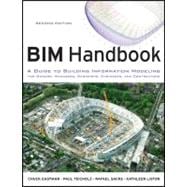
Note: Supplemental materials are not guaranteed with Rental or Used book purchases.
Purchase Benefits
What is included with this book?
Paul Teicholz is Professor Emeritus at Stanford University. After twenty-five years innovating with IT solutions in the construction industry, he founded the Center for Integrated Facility Engineering (CIFE) at Stanford in 1988 and directed that program for tenyears. He was named the Construction Management "Man of the Year" by the American Society of Civil Engineers in 1985 and awarded the Henry C. Turner Prize for Innovation in Construction Technology by the National Building Museum in 2006.
Rafael Sacks is an Associate Professor in Structural Engineering and Construction Management at Technion–Israel Institute of Technology. He founded and leads the Virtual Construction and BIM Laboratory at the Israel National Building Research Institute, and has conducted primary and applied BIM research for industry, government, and public organizations in North America, Europe, and Israel.
Kathleen Liston is CEO of Eco Offsite, a modular construction company. She co-founded Common Point Technologies, Inc., a construction simulation software company. She has worked with a variety of organizations, including Autodesk, Walt Disney, DPR Construction, and Mortenson Construction, developing technologies and processes to implement BIM. She has a PhD and master's from Stanford University in civil and environmental engineering and a bachelor of architecture from the University of Notre Dame.
Preface.
Chapter 1 BIM Handbook Introduction.
1. 0 Executive Summary.
1.1 Introduction.
1.2 The Current AEC Business Model.
1.3 Documented Inefficiencies of Traditional Approaches.
1.4 BIM: New Tools and New Processes.
1.5 What Is Not BIM Technology.
1.6 What Are the Benefits of BIM? What Problems Does It Address?
1.7 What Challenges Can Be Expected?
1.8 Future of Designing and Building with BIM (Chapter 8).
1.9 Case Studies (Chapter 9).
Chapter 1 Discussion Questions.
Chapter 2 BIM Design Tools and Parametric Modeling.
2.0 Executive Summary.
2.1 The Evolution to Object-based Parametric Modeling.
2.2 Parametric Modeling of Buildings.
2.3 Beyond Parametric Shapes.
2.4 BIM Environments, Platforms and Tools.
2.5 Overview of the Major BIM Design Platforms.
2.6 BIM Platforms.
2.7 Lightweight Modeling Applications.
2.8 Conclusion.
Chapter 2 Discussion Questions.
Chapter 3 Interoperability.
3.0 Executive Summary.
3.1 Introduction.
3.2 Different Kinds of Exchange Formats.
3.3 Background of Product Data Models.
3.4 Other Efforts Supporting Standardization.
3.5 The Evolution from File-based Exchange to Building Model Repositories.
3.7 Summary.
Chapter 3 Discussion Questions.
Chapter 4 BIM for Owners and Facility Managers.
4.0 Executive Summary.
4.1 Introduction: Why Owners Should Care About BIM.
4.2 BIM Application Areas for Owners.
4.5 BIM Tool Guide for Owners.
4.6 An Owner and Facility Manager’s Building Model.
4.7 Leading the BIM Implementation on a Project.
4.8 Barriers to Implementing BIM: Risks and Common Myths.
4.9 Guidelines and Issues for Owners to Consider When Adopting BIM.
Chapter 4 Discussion Questions.
Chapter 5 BIM for Architects and Engineers.
5.0 Executive Summary.
5.1 Introduction.
5.2 Scope of Design Services.
5.3 BIM Use in Design Processes.
5.5 Considerations in Adoption for Design Practice.
5.6 New and Changed Staffing within Design Firms.
Chapter 5 Discussion Questions.
Chapter 6 BIM for the Construction Industry.
6.0 Executive Summary.
6.1 Introduction.
6.2 Types of Construction Firms.
6.3 Information Contractors Want from BIM.
6.4 Processes to Develop a Contractor Building Information Model.
6.5 Reduction of Design Errors Using Clash Detection.
6.6 Quantity Takeoff and Cost Estimating.
6.7 Construction Analysis and Planning.
6.8 Integration with Cost and Schedule Control and Other Management Functions.
6.9 Use for Offsite Fabrication.
6.10 Use of BIM Onsite: Verification, Guidance, and Tracking of Construction Activities.
6.11 Synergies of BIM and Lean Construction.
6.12 Implications for Contract and Organizational Changes.
6.12 BIM Implementation.
Chapter 6 Discussion Questions.
Chapter 7 BIM for Subcontractors and Fabricators.
7.0 Executive Summary.
7.1 Introduction.
7.2 Types of Subcontractors and Fabricators.
7.3 The Benefits of a BIM Process for Subcontractor Fabricators.
7.4 BIM-Enabled Process Change.
7.5 Generic BIM System Requirements for Fabricators.
7.6 Major Classes of Fabricators and Their Specific Needs.
7.7 Adopting BIM in a Fabrication Operation.
7.8 Conclusions.
Chapter 7 Discussion Questions.
Chapter 8 The Future: Building with BIM.
8.0 Executive Summary.
8.1 Introduction.
8.2 The Development of BIM Up to 2010.
8.3 Current Trends.
8.4 Vision 2015.
8.5 Drivers of Change and BIM Impacts up to 2020.
Chapter 9 BIM Case Studies.
9.0 Introduction.
9.1 Aviva Stadium.
9.2 Courtyard by Marriott.
9.3 Sutter Medical Center Castro Valley.
9.4 Maryland General Hospital.
9.5 Crusell Bridge.
9.6 100 11th Avenue, New York City.
9.7 One Island East Project, Hong Kong.
9.8 Helsinki Music Centre.
9.9 Hillwood Commercial Project.
9.10 United States Coast Guard BIM Implementation.
Glossary.
Bibliography.
Index.
The New copy of this book will include any supplemental materials advertised. Please check the title of the book to determine if it should include any access cards, study guides, lab manuals, CDs, etc.
The Used, Rental and eBook copies of this book are not guaranteed to include any supplemental materials. Typically, only the book itself is included. This is true even if the title states it includes any access cards, study guides, lab manuals, CDs, etc.